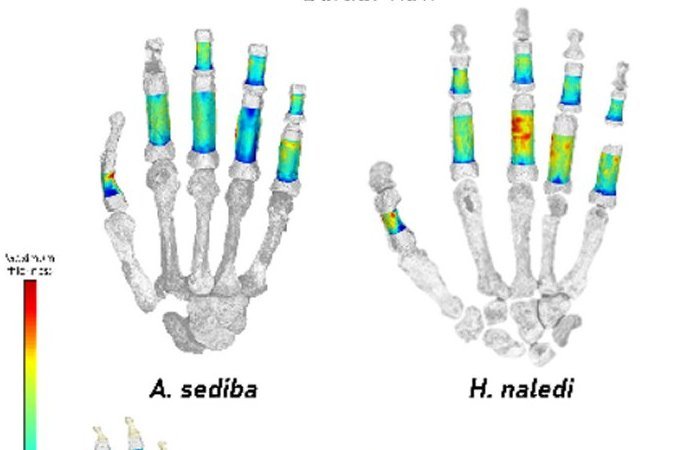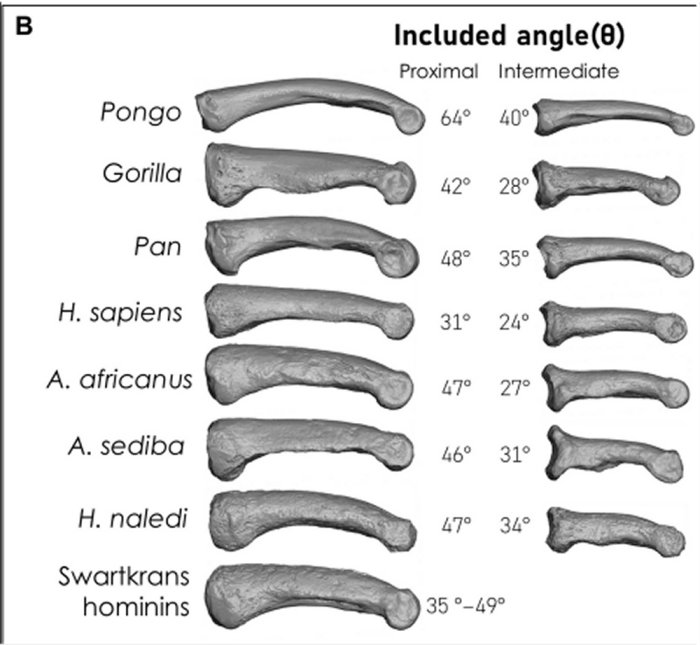Conny Waters – AncientPages.com – Scientists have found new evidence for how our fossil human relatives in South Africa may have used their hands.
3D color maps of cortical bone distribution in fossil and extant hominin phalanges. Image credit: Syeda et al., Sci. Adv. 11, eadt1201 (2025)
Their study focused on two ancient human relatives, Australopithecus sediba and Homo naledi, who had different finger bone morphologies, and could use different hand grips, necessary for using tools and for climbing.
Research team led by Samar Syeda, postdoctoral researcher at the American Museum of Natural History, together with scientists at the Max Planck Institute for Evolutionary Anthropology, the University of the Witwatersrand, University of Kent, Duke University and the National Geographic Society, focused on two, almost complete fossil hand skeletons found in South Africa.
One hand is that of Australopithecus sediba was discovered in 2010 at the site of Malapa and dated to approximately two million years old.
Malapa (discovered in 2008) is a fossil-bearing cave in South Africa widely known for the most complete skeletons of early human ancestors Australopithecus sediba.
The other hand skeleton is from the more recent, but perhaps more enigmatic, Homo naledi, first found in 2015 deep within the Rising Star Cave system and dated to around 250,000 years ago.
While we haven’t yet discovered direct evidence of hominins using stone tools, the fascinating features of their hand and wrist structures inspire us to imagine their potential.
These characteristics suggest a remarkable level of dexterity, much more similar to that of humans than that of our primate cousins, like chimpanzees or gorillas.
“Since stone tools are found in South Africa by at least 2.2 million years ago (and in East Africa by as early as 3.3 million years ago), and many primates are all excellent stone tool users, it is not surprising that A. sediba and H. naledi would be dexterous tool users as well. However, how exactly they used tools and if they manipulated their tools in similar ways is unclear,” says senior author, Tracy Kivell.
Standardized average J and phalangeal curvature of A. sediba and H. naledi in relation to an extant and fossil comparative sample. (B) Phalangeal curvature measured via included angle, with images depicting proximodistal curvature of the dorsal shaft in a representative third proximal and intermediate phalanx for each taxon. Reported curvature values represent the average of digits 2 to 5 for the proximal and intermediate phalanges. Syeda et al., Sci. Adv. 11, eadt1201 (2025)
Furthermore, both *Australopithecus sediba* and *Homo naledi* are accompanied by numerous skeletal remains that exhibit ape-like characteristics. Notably, the bones of their upper limbs display features that would be particularly advantageous for climbing.
Whether these features represent climbing abilities in these individuals or are merely evolutionary remnants from an ancestor adept at climbing is a fascinating debate, which still continues.
Fossil hands are a fascinating part of ancient human behavior. Therefore, the researchers studied the cortical bone in the fingers of A. sediba and H. naledi. Bone adapts its structure based on use, becoming thicker with higher loads and thinner with lower loads. Variations in cortical thickness can reveal how these hominins used their hands during their lifetime
“We found that A. sediba and H. naledi show different functional signals in the cortical bone structure of their fingers,” says Samar Syeda, lead author of the study.
The fossil hands of Australopithecus sediba (around two million years old) and Homo naledi (around 250,000 years old) show that these South African hominins may have had different levels of dexterity, as well as different climbing abilities. © Tracy Kivell
In A. sediba, the cortical bone distribution in most finger phalanges resembles apes, but the thumb and pinky are more human-like.
“These two digits are more likely to reflect potential signals of manipulation because they are less often used or experience less load during climbing or suspensory locomotion,” Syeda explains.
“When we combine these results with the remarkably long, human-like thumb of A. sediba, it suggests that A. sediba used its hand for both tool use and other dexterous behaviours, as well as climbing.”
Homo naledi‘s hands have unusual grip pattern showing human-like proximal phalanges (articulating with the palm) but ape-like intermediate phalanges (middle finger bones).
“This distinct pattern was unexpected and indicates that H. naledi likely used and loaded different regions of its fingers in different ways,” says Syeda.
Interestingly, this kind of loading pattern is typical of only certain grip types used today, like crimp grips, which are often used by rock climbers. In these grips, the surface is grasped primarily by the tips of the fingers.
- naledialso has unusually highly curved finger bones, particularly for a hominin that lived at the same time as the earliest members of our species, Homo sapiens, which is another indication that it used its hands for locomotion.
More research is needed to determine if H. naledi used crimp-like grips or climbed rocks.
Throughout human evolution, enhanced dexterity for tools and food processing combined with the need to climb trees or rocks in the South African palaeolandscape.
“This work offers yet more evidence that human evolution is not a single, linear transition from upright walking to increasingly better tool use, but is rather characterized by different ‘experiments’ that balanced the need to both manipulate and to move within these past environments,” says Kivell.
Written by Conny Waters – AncientPages.com Staff Writer







Recent Comments